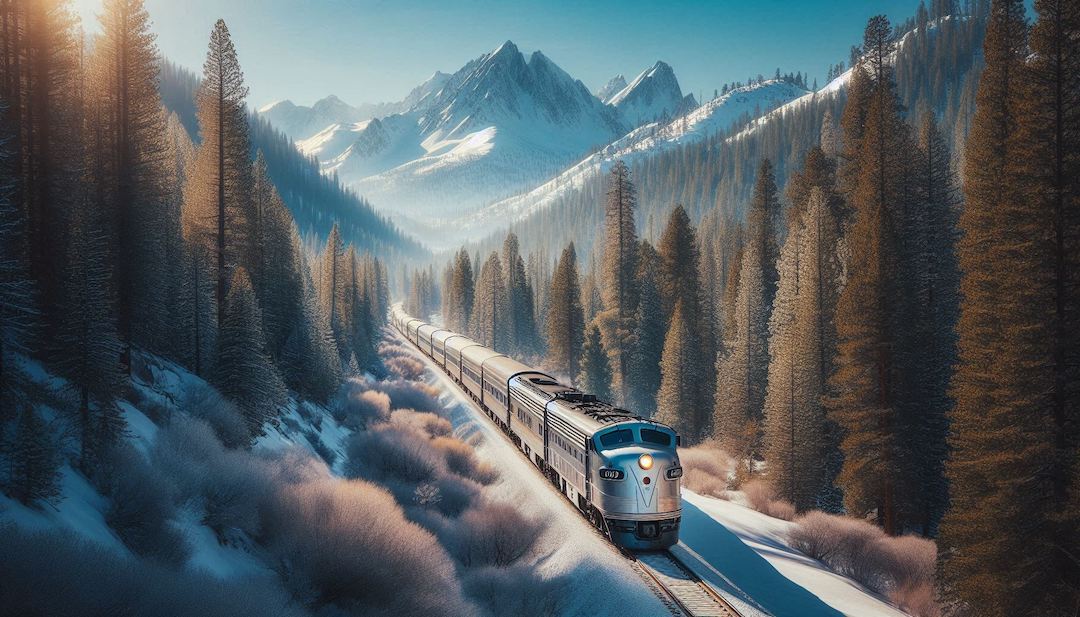
CHICAGO (Illinois) – Everyone was chatting away enthusiastically. A group of men had gathered around, boisterously playing cards. At the far end, a woman wearing a headscarf quietly knitted, paying no mind to the noise around her. A few children divided up some pastries, laughing with innocent delight. Suddenly, someone shouted, “Look over there—someone’s running this way!” A cloud of dust on the horizon grew more visible. It turned out to be a group of riders thundering across the plains on horseback, wearing brightly colored eagle-feather headdresses, their faces painted white, red, and yellow in fierce, intimidating patterns. They yelled as they galloped toward the train. Clearly, these were Native Americans—perhaps Cherokee, Choctaw, Cheyenne, or another tribe—uninvited guests. Before long, they caught up and began shooting arrows at the train cars. While the children cowered under their seats, the men and women aboard were ready. Handguns and rifles—Winchesters, Colts—started firing. Arrows flew in from outside; muzzle flashes lit up inside. Someone went down… It was a dramatic scene straight out of a classic Western, the kind Hollywood staged based on the bygone era when white settlers built and ran the transcontinental railroad from east to west across America, dating all the way back to 1804—before the Civil War.
But that was decades ago, back when much of the country was still wild, and Native American warriors and bandits regularly attacked trains that passed through their lands. Infamous “heroes” like Jesse James, Frank James, and Butch Cassidy made their names with successful train robberies, while gunslingers who were slow on the draw—like Wyatt Earp or Wild Bill Hickok—met their fate or rose to fame during the tumultuous “Wild, Wild West.” Of course, that’s all in the past. Today, the California Zephyr chugs along almost 2,400 miles (close to 4,000 kilometers) with numerous stops, from Emeryville in California to its final destination in Chicago, Illinois. It’s a fascinating, lively, yet peaceful journey—albeit a bit shaky at times. The Zephyr travels through stunning and majestic scenery: rolling hills, rivers and streams, pine forests, grassy plains, farmland, and sprawling cattle ranches stretching all the way to the horizon. Going from west to east, you’ll truly appreciate just how vast and magnificent the United States is, with its climate changing noticeably from one state to the next—and of course, the time zones shift as well. Little wonder the California Zephyr is often called one of the most beautiful train journeys in North America.
Departure: Emeryville
Built north of San Francisco, Emeryville Station only came into being in 1993, and it officially became the western terminus for the California Zephyr in 1994—even though the route itself had been running since 1949, according to Wikipedia. The station also serves other Amtrak lines like the Capitol Corridor, Coast Starlight, and San Joaquins. To clarify, each of Amtrak’s train routes has its own name. Emeryville is simply referred to as a “Station,” whereas larger, grander hubs are known as “Union Station.” So, if you want to ride the California Zephyr to Chicago, you have to start at Emeryville Station. Passengers coming from Southern California—such as San Diego, Orange County, Los Angeles, or from San Jose and San Francisco—often take an Amtrak train or bus to Emeryville and then head east from there.
Now, let’s hop aboard the California Zephyr. The horn blares loudly, and the train slowly pulls out of the station. On the platform below, friends and family wave their goodbyes, and passengers on board blow kisses in return. Those departing are seen off right at the train door—no endless lines for security or ID checks like at the airport, no removing your shoes and jacket or raising your arms for a full-body scan. That’s the advantage of train travel. The downside is that it can be a long, swaying journey before you finally arrive. But only those who relish a slower pace—who aren’t caught up in the hustle and bustle of daily life—would choose the train, giving themselves ample time to reflect on life, on others, and maybe even on love stories past and future. If you want to reach Chicago’s Union Station, for instance, you’ll pass through 35 stops over roughly 52 hours, covering about 2,400 miles and spending two nights on the train. In return—something you can’t get by plane—you’ll witness breathtaking scenery reminiscent of a young, untamed America.
Crossing from California into Nevada, then Utah, Colorado, Nebraska, Iowa, and finally reaching Chicago, Illinois, the train is known as Zephyr 6 going east and Zephyr 5 going west. You might leave California’s warm sunshine only to find that, once the train ascends the Rocky Mountains or enters the Sierra Nevada, you’re surrounded by endless forests and snow-covered peaks if it’s winter. In Utah, you’ll see towering, brilliantly red rock formations with unusual shapes. Then in Colorado, those red hues fade into ranges worn smooth by time, covered in lush green pines. After leaving Iowa, the train crosses the murky, rushing waters of the Mississippi before entering Illinois. As you reach the Midwest, you’ll see vast farmlands—some dedicated to raising cattle, others to growing crops. Off in the distance, you might spot herds of goats or cattle quietly grazing on golden grass, oblivious to the serpentine Zephyr rolling by. Sometimes, you’ll catch a glimpse of a bright red-roofed house beside a slow-moving river, much like in old Western movies. Early pioneers or gold-seekers once built their homes near creeks or lakes to secure water for drinking and farming. You may even see old-fashioned windmill pumps spinning furiously, a stark contrast to the giant, slow-turning blades of modern wind turbines. Watching this all slip behind you from the “observation car”—whose walls and ceiling are made of glass—while the Zephyr steadily forges ahead, or enjoying three hearty meals a day (breakfast, lunch, and dinner) from a menu of your choice, are all part of the everyday Amtrak experience. A friendly conductor in each car may help you convert your seats into a bed, prepare a pot of fresh coffee in the morning, or remind you of your upcoming stop. These are all minor details compared to Amtrak’s biggest issue: delays.
A Big Problem
Indeed, delays and breakdowns have long been chronic issues for Amtrak. In fact, the U.S. Congress recently got involved through a proposed bill, H.R. 769, introduced by Representatives Josh Gottheimer (D-NJ) and Thomas Kean (R-NJ). The bill would require the Department of Transportation to set rules forcing Amtrak to refund passengers if their train is delayed more than three hours or if a trip is canceled due to Amtrak’s fault. According to an article on the “Railway Supply” website, despite federal funding, Amtrak continues to face major hurdles and hasn’t shown significant improvement. Outdated infrastructure, aging locomotives, a shortage of replacement parts, and frequent maintenance are compounded by the fact that passenger trains share tracks with freight trains—if one side experiences a problem, the other has to wait, sometimes for hours. Another reason, the article suggests, could be ineffective management leading to these persistent challenges. In short, a comprehensive overhaul is needed, from Amtrak’s core operations to upgrading rail lines and rolling stock, switching from diesel to electric, and addressing many other issues to align with the government’s focus on streamlining and budget efficiency, all while improving customer service. Amtrak has plans to introduce high-speed bullet trains, which are quieter, faster, reduce travel time, and are far more environmentally friendly.
No one can deny Amtrak’s importance—or do away with it entirely—because it remains a crucial transportation link connecting major cities with remote rural areas, serving tens of thousands of passengers and preserving the cherished legacy of a rail system that has been around for over four decades.
Arrival: Chicago
After all the chugging and swaying, delays here and crew changes there, the California Zephyr finally blows its whistle and rumbles into Chicago Union Station. Following a long, exhausting journey, passengers hurry off the train to greet and embrace family or friends waiting right at the doors. The conductor rushes to collect trash and tidy up the sleeping compartments—whether a roomette with two seats that convert into bunk beds and shared restrooms, or a larger bedroom with a private toilet and shower—that have just been vacated. Meanwhile, Amtrak staff get to work inspecting each car, checking every part of the locomotive so that, the very next day, California Zephyr 6 can be rebranded as California Zephyr 5 and make its return trip from Chicago to Emeryville.
When departure time comes, the train horn echoes loudly once again.
“ALL ABOARD!”
-Đức Hà-
Exclusive for Huutri.org
